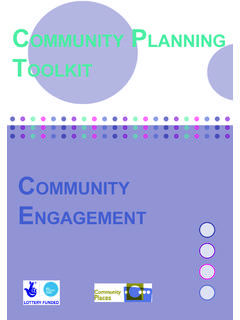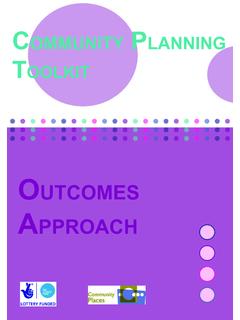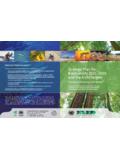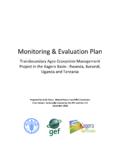Transcription of Community Planning
1 Community Planning Toolkit - Community PlanningCommunityPlanning Community Planning toolkitCommunity Planning Toolkit - Community PlanningDeveloped by Community Places through the support of the BIG Lottery Planning Toolkit - Community PlanningContents1. Introduction 032. Introducing Community Planning 033. Distinctive Qualities of 05 Community Planning 4. Community Planning in Action 085. Community Development Support 126. Skills and Knowledge 16 1. Introduction This section of the Toolkit: introduces and explains Community Planning ; focuses on its distinctive qualities; explains what the legal duties will be in the region; gives examples of Community Planning in action; outlines the support communities need; and presents the types of skills and knowledge needed for Community Introducing Community Planning Community Planning has evolved over many years from local Community action plans to plans developed jointly by communities, public (statutory) bodies and local councils.
2 While this Toolkit will help you with whatever form of Community Planning you are involved in now it has been developed with the re-structuring of local councils and the introduction of a new statutory duty of Community Planning in mind. This new form of Community Planning will aim to improve the effectiveness of public services in meeting people s needs, support the development of local communities and improve the quality of life for Planning will: Be facilitated and led by the new local councils; Include a duty to engage with people and communities; and Require all public service organisations to co-operate in developing and implementing the agreed Community new form of Community Planning will be introduced as part of the legislation which will establish new councils.
3 The reform of council structures and roles is designed to improve public services and make them more responsive to the needs of local people and communities. Community Planning , led and facilitated by the new councils, is central to these aims and to how councils will work with Community and voluntary groups in the future. It is proposed R1 that the new councils will be: Expected to consult and co-operate with all bodies responsible for providing public services; Expected to engage with the Community , other bodies and individuals in Planning the provision of public services; Required to publish, review and amend Community plans to reflect changes in the their area; Required to publish reports on Community Planning including public service improvements.
4 The content, frequency and form of these reports will be specified by the Department .It is also proposed that all departments in the region will be: Required to promote Community Planning and have regard to Community Planning Toolkit - Community PlanningOther public (statutory) bodies across the region will be required to: Participate in and assist Community Planning . These proposals for Community Planning arose out of the wider Review of Public Administration (RPA) which examined how public services are planned, co-ordinated and provided here and in other jurisdictions and the role of local councils.
5 This work R2 included research into different forms of Community Planning here and in England, the Republic of Ireland, Scotland an d Wales. In Scotland the fundamental building blocks of Community Planning are in legislation, Local Government Act (2003), and it is this legislative approach that is being adopted here. It is proposed that there be four inter-linked Community Planning legal duties introduced: A duty on new councils to lead and facilitate; A duty of Community engagement; A duty on public (statutory) bodies to support and participate; A duty on Government Departments to have regard to Community PlansIn addition a Power of Well-being will be given to the new councils.
6 It is proposed that this new power would enable councils to respond to issues identified through Community Planning by undertaking actions which are not already the responsibility of another agency (unless given permission to do so by the agency). 45 Community Planning Toolkit - Community PlanningThematic Partnership LevelLocal Area LevelStrategic LevelLayers of Community Planning3. Distinctive Qualities of Community Planning Community Planning will be an ongoing, rolling process of Planning , delivering and reviewing. It will thus not be like previous initiatives which have a fixed lifespan.
7 The engagement of people and communities will be a legal duty supported by statutory guidance which will be binding (as it is in Scotland) R3. See Toolkit: Community Engagement for guidance and resources on engagement. Local councils and councillors will play a leading and facilitating role in the development of Community Plans. This will provide opportunities for Community and voluntary groups and local councillors to work more closely together in ensuring that the needs of communities are recognised, understood and tackled by all public (statutory) agencies.
8 This is developed in more detail inToolkit: Working Together. Public (statutory) agencies in health, education, housing and so on will be legally required to work with the new councils and Community partners in the development and implementation of Community Plans. Their involvement will thus be on a different basis from current and past processes and programme initiatives. There will be a sharp focus on delivering better outcomes from public and Community services and investment and thus improving the quality of life for people and communities in greatest need - See Toolkit: Outcomes Approach.
9 The legislation will require one overall Community plan for each of the new council areas. The councils, Community and other partners can decide to also develop local area Community Plans and Plans for particular themes ( Community safety, good relations, health and well-being, children and young people). These local and thematic Community Plans would be linked to the overall council-wide Community plan and show how it would be implemented in the local areas or relevant themes. These layers of Community Planning are illustrated in Diagram 1: Ministers have stated that there will be a statutory (legal) link between Community Plans and (land use/spatial) Development Plans.
10 This will mean that the Community plan will set the aims and priorities for the zoning of land. This statutory link between the two plans will be particularly useful in addressing segregation along economic, social and cultural lines by providing a platform to address complex issues of multiple deprivation, contested space and Community cohesion. It will also provide the opportunity to share Community engagement, research data and evidence and monitoring and review processes. This will help to minimise consultation fatigue, make best use of resources and more closely align the aims and priorities of both plans.










